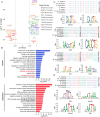Evolution of cetacean-specific conserved non-coding elements suggests their role in the limb changes during secondary aquatic adaptation
- PMID: 40670992
- PMCID: PMC12269289
- DOI: 10.1186/s12915-025-02300-0
Evolution of cetacean-specific conserved non-coding elements suggests their role in the limb changes during secondary aquatic adaptation
Abstract
Background: Limb morphology is particularly important for animals to inhabit different environments. Limb modifications (e.g., flipper-like forelimbs and hindlimb regression) are among the most critical secondary aquatic adaptation mechanisms enabling cetaceans to fully adapt to an aquatic environment. Exploring the molecular mechanisms underlying limb evolution in cetaceans has attracted considerable attention from evolutionary biologists.
Results: In the present study, conserved non-coding elements (CNEs) closely associated with limb development, which exhibited lineage-specific sequence divergence (nucleotide mutations and indels) in cetaceans, were identified using comparative genomics. These sequence divergences might have led to the loss of binding motifs for transcription factors involved in limb development and significant alterations in autoregulatory activity. A transgenic mouse was constructed to carry a cetacean-specific enhancer (i.e., hs1586), which exhibited a significant phenotypic difference in forelimb buds at embryonic day (E)10.5, supported by transcriptomic and epigenomic evidence. However, the phenotypic recovery after E11.5 suggested that enhancer redundancy in the mouse genome may have compensated for the effects caused by the incorporation of cetacean hs1586. This further suggests that the complex phenotypic changes of limbs in cetaceans are likely not driven by a single CNE but rather involve multiple CNEs and/or genes.
Conclusions: In summary, our study supports the functional role of CNE sequence divergence and the complex mechanisms underlying limb morphology changes in cetaceans.
Keywords: CNEs; Cetaceans; Limb morphology; Phenotypic recovery; Transgenic mice.
© 2025. The Author(s).
Conflict of interest statement
Declarations. Ethics approval and consent to participate: All animal experiments in this manuscript were conducted according to the Animal Care and Use Committee of Nanjing Normal University (ethics approval number: IACUC-20200501). Consent for publication: Not applicable. Competing interests: The authors declare no competing interests.
Figures





Similar articles
-
Adaptive evolution of BMP4 as a potential mechanism for flipper forelimb changes in cetaceans.Zool Res. 2025 May 18;46(3):675-683. doi: 10.24272/j.issn.2095-8137.2024.473. Zool Res. 2025. PMID: 40407132 Free PMC article.
-
Relaxed selection in evolution of genes regulating limb development gives clue to variation in forelimb morphology of cetaceans and other mammals.Proc Biol Sci. 2024 Oct;291(2032):20241106. doi: 10.1098/rspb.2024.1106. Epub 2024 Oct 9. Proc Biol Sci. 2024. PMID: 39378996
-
Short-Term Memory Impairment.2024 Jun 8. In: StatPearls [Internet]. Treasure Island (FL): StatPearls Publishing; 2025 Jan–. 2024 Jun 8. In: StatPearls [Internet]. Treasure Island (FL): StatPearls Publishing; 2025 Jan–. PMID: 31424720 Free Books & Documents.
-
The Black Book of Psychotropic Dosing and Monitoring.Psychopharmacol Bull. 2024 Jul 8;54(3):8-59. Psychopharmacol Bull. 2024. PMID: 38993656 Free PMC article. Review.
-
A rapid and systematic review of the clinical effectiveness and cost-effectiveness of paclitaxel, docetaxel, gemcitabine and vinorelbine in non-small-cell lung cancer.Health Technol Assess. 2001;5(32):1-195. doi: 10.3310/hta5320. Health Technol Assess. 2001. PMID: 12065068
References
-
- Seki R, Kamiyama N, Tadokoro A, Nomura N, Tsuihiji T, Manabe M, Tamura K. Evolutionary and developmental aspects of avian-specific traits in limb skeletal pattern. Zoolog Sci. 2012;29(10):631–44. - PubMed
-
- Mann A, Pardo JD, Maddin HC. Snake-like limb loss in a Carboniferous amniote. Nat Ecol Evol. 2022;6(5):614–21. - PubMed
-
- Schwaner MJ, Lin DC, McGowan CP. Jumping mechanics of desert kangaroo rats. J Exp Biol. 2018;221(Pt 22):jeb186700. - PubMed
-
- Legreneur P, Monteil KM, Pelle E, Montuelle S, Bels V. Submaximal leaping in the grey mouse lemur. Zoology (Jena). 2011;114(4):247–54. - PubMed
-
- Lambert O, Bianucci G, Salas-Gismondi R, Di Celma C, Steurbaut E, Urbina M, de Muizon C. An amphibious whale from the Middle Eocene of Peru reveals early south pacific dispersal of quadrupedal cetaceans. Curr Biol. 2019;29(8):1352-1359 e1353. - PubMed
MeSH terms
LinkOut - more resources
Full Text Sources
Molecular Biology Databases

